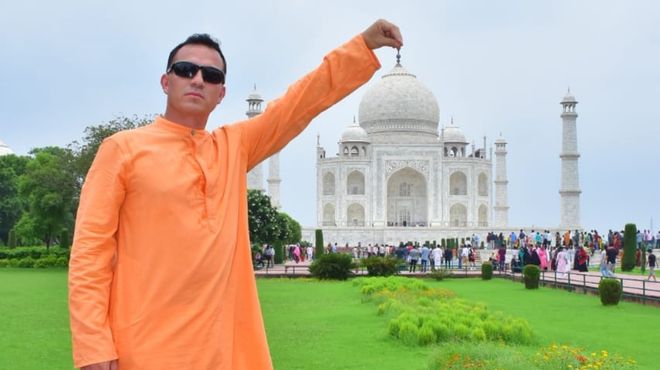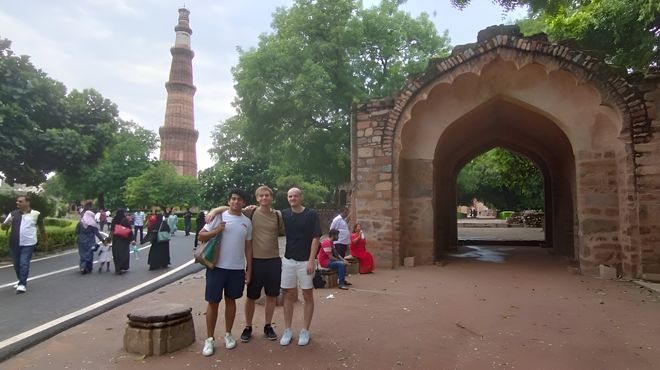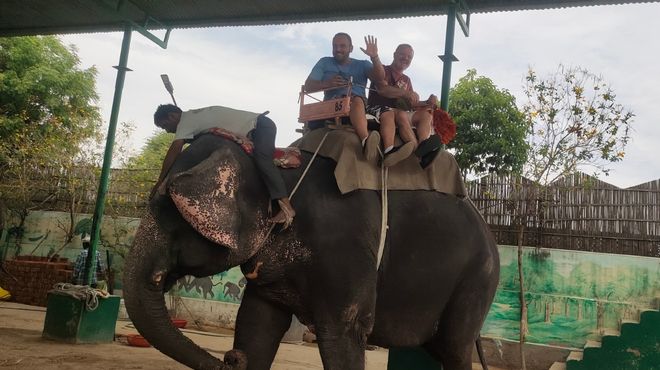Day 01: Delhi >
Sightseeing > Delhi
Morning
Smooth pick-up from your location
Our friendly guide will meet you at your designated
location Delhi or nearby Delhi to ensure a smooth start to your journey.
Red Fort
The fort is structured in a traditional Mughal style,
with a series of pavilions, palaces, and gardens within its complex. Notable
structures within the fort include the Diwan-i-Aam (Hall of Public Audience),
Diwan-i-Khas (Hall of Private Audience), the Nahr-i-Bihisht (Stream of
Paradise), and the Moti Masjid (Pearl Mosque). Each component of the fort serves
a specific purpose, reflecting the opulence and functionality of Mughal
architecture. The Red Fort stands as an architectural masterpiece that
encapsulates the grandeur and cultural richness of India's Mughal heritage. Its
significance extends beyond its physical structures, embodying the spirit of a
bygone era and serving as a timeless symbol of India's historical legacy.
Jama Masjid
This mosque commissioned by the fifth Mughal Emperor,
Shah Jahan, and completed in 1656, this grand architectural marvel stands as a
testament to the Mughal era's cultural and religious significance. Jama Masjid
stands not only as a place of worship but also as a remarkable architectural
masterpiece that reflects the cultural and religious diversity of India. Its
grandeur and historical significance make it a must-visit destination for those
exploring the rich tapestry of Delhi's heritage.
Humayun's Tomb
Humayun's Tomb, located in the heart of Delhi, is a
UNESCO World Heritage Site and an architectural masterpiece that predates the
Taj Mahal. Built in the mid-16th century, this tomb serves as the final resting
place of the Mughal Emperor Humayun. The serene and majestic garden tomb complex
is a prime example of Mughal architecture and a key attraction in Delhi. This
tomb stands as a timeless testament to Mughal architectural brilliance and is a
must-visit destination for those seeking a glimpse into India's rich history and
cultural heritage. The harmonious blend of garden design and intricate
architecture makes it a tranquil retreat in the bustling city of Delhi.
Lotus Temple
The Lotus Temple, located in New Delhi, India, is a
renowned architectural marvel and a Bahá'í House of Worship. This unique
structure, completed in 1986, is celebrated for its distinctive lotus flower
shape and serves as a symbol of unity, welcoming people of all religions and
backgrounds. The Lotus Temple stands as a symbol of architectural beauty,
spiritual unity, and the Bahá'í principles of peace and equality. Its
distinctive design and inclusive ethos make it a must-visit destination for
those seeking a unique spiritual and cultural experience in the heart of Delhi.
Lunch
Indulge in a quintessential Delhi lunch that takes you
on a flavorful journey through the city's diverse culinary tapestry. Begin with
iconic snacks like Aloo Tikki Chaat and succulent kebabs, including seekh and
galouti kebabs. For the main course, savor the richness of Butter Chicken, the
spiciness of Chole Bhature, and the comfort of Rajma Chawal or Paneer Tikka.
Accompanied by refreshing Raita and pickles, pair these dishes with a choice of
naan or roti. Conclude your meal with sweet delights like Jalebi with Rabri and
Gulab Jamun. Wash down the flavors with a traditional Lassi. This comprehensive
Delhi lunch experience captures the city's culinary essence, from street food to
traditional delights, leaving you with a satisfied palate and a taste of Delhi's
vibrant food culture.
Afternoon
Qutub Minar
Qutub Minar, a UNESCO World Heritage Site in South
Delhi, is an architectural marvel dating back to the early 13th century.
Commissioned by Qutb-ud-din Aibak, it stands as the world's tallest brick
minaret at 73 meters. The intricately adorned structure features five tiers with
projecting balconies, showcasing a blend of Indo-Islamic architectural styles.
Part of the larger Qutb Complex, which includes the Quwwat-ul-Islam Mosque and
the Iron Pillar of Delhi, the site holds historical significance as a symbol of
victory and religious heritage. Visitors can explore the complex, climb the
minaret for panoramic views, and appreciate the detailed carvings and
calligraphy that narrate Delhi's diverse history. Open throughout the week,
Qutub Minar remains a captivating destination, inviting exploration into the
cultural tapestry of the city.
President House
Pass by the grandeur of Rashtrapati Bhavan, the official
residence of the President of India. The impressive structure stands as a symbol
of architectural magnificence, nestled in the heart of Delhi. With its vast
expanse and intricate detailing, Rashtrapati Bhavan commands attention,
embodying the dignity and authority associated with the highest office in the
country. As you traverse the city, a glimpse of this iconic landmark offers a
visual representation of India's political heritage and the prestigious role of
its head of state.
Akshardham
Akshardham, an epitome of artistic magnificence, stands
at Delhi's heart, seamlessly blending spirituality and culture. This
Swaminarayan Akshardham Temple is a visual symphony, with its central monument,
intricately carved from pink sandstone and white marble, narrating ancient
Indian tales through exquisite sculptures and majestic domes. The Mandovar
offers a serene boat ride through cultural heritage, while the Sahaj Anand Water
Show employs multimedia to recount Lord Swaminarayan's enlightening
conversations. The Yagnapurush Kund, the world's largest stepwell, showcases a
perfect fusion of art, spirituality, and devotion. Akshardham transcends
traditional boundaries, inviting visitors into a captivating realm where every
detail resonates with India's rich cultural tapestry.
India Gate
India Gate, a symbol of national pride and sacrifice,
graces the heart of New Delhi. Erected as a war memorial, this iconic structure
commemorates the Indian soldiers who lost their lives during World War I.
Designed by Sir Edwin Lutyens, the India Gate stands at a height of 42 meters
and is inspired by the Arc de Triomphe in Paris. The monument is a triumphal
arch, constructed with red sandstone and granite, adorned with intricate
carvings and inscriptions. The names of over 13,000 soldiers are inscribed on
the walls, immortalizing their sacrifice. Surrounded by lush lawns, the India
Gate offers a poignant and reflective space, particularly when illuminated in
the evening. Beyond its historical significance, the India Gate stands as a
timeless symbol of India's unity, courage, and indomitable spirit.
Parliament House
Admire the architecture of the Parliament House. The
Parliament House of Delhi, or Sansad Bhavan, is a distinguished circular edifice
designed by Sir Edwin Lutyens and Herbert Baker in 1927. Symbolizing unity, it
houses the Lok Sabha, Rajya Sabha, and Central Library. The classical exterior
and detailed interiors showcase its significance in India's democratic
governance. Set amid expansive lawns, the Parliament House stands as a central
hub for legislative proceedings, embodying the core of India's political
landscape.
Evening
Walking Tour (Chandni Chowk)
Embark on a vibrant rickshaw ride, immersing youself in
a sensory tapestry of sights, sounds, and aromas. Engage in the lively
marketplace ambiance as you skillfully negotiate for aromatic spices and
luxurious silks, an integral part of the traditional shopping experience.
Enhance your culinary exploration by savoring delectable street food treasures
like crispy jalebis, sweet swirls of deep-fried batter soaked in sugar syrup,
and piping hot samosas, golden pockets of spiced potatoes encased in a crispy
pastry. This immersive journey provides a firsthand encounter with the rich
cultural and gastronomic offerings, adding layers of authenticity to your
exploration of the vibrant local markets.
Overnight in Delhi
Rest and rejuvenate for the next day's adventures.










